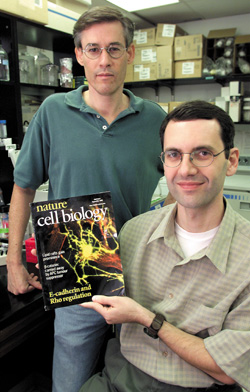
Albert Reynolds, Ph.D., left, and Panos Anastasiadis’, Ph.D., research is featured on the cover of September’s issue of Nature Cell Biology. (photo by Dana Johnson)
Protein’s role in metastasis examined
Having your picture on the cover of an international magazine is a big deal–even if it’s not your smiling face, but instead is a photograph of the cells you study in the lab.
The cover of September’s issue of Nature Cell Biology features the work of Vanderbilt University Medical Center investigators. It shows a brightly colored cell that looks somewhat like a lightning storm, illustrating what happens when cells produce too much of a protein involved in determining cell shape and stickiness.
The protein, called p120 catenin, has been a research interest for Albert B. Reynolds, Ph.D., associate professor of Cancer Biology, since he discovered it in 1989. Mounting evidence suggests that p120 participates in processes that govern whether a cancer cell becomes metastatic – capable of dislodging from surrounding cells and moving to a new site in the body. Drugs that block p120’s actions could be useful inhibitors of metastasis.
Reynolds originally identified p120 as one of the proteins acted on by the enzyme src, the first described oncogene. The protein sequence of p120 looked like a cell adhesion molecule called beta-catenin, turning Reynolds’ attention to processes of cell-cell interaction.
“When we were looking for src substrates, we were thinking about cell growth–why cancer cells grew faster,” Reynolds said. “But some cancer cells actually grow very slowly, and what’s wrong is that they don’t recognize their neighbors and stop growing.”
With a failure to recognize neighbors comes a change in cell shape.
“One of the hallmarks of cancer is that the cells have altered morphology,” said Panos Anastasiadis, Ph.D., postdoctoral fellow in Cell Biology and lead author of the group’s Nature Cell Biology paper. “And the worse the cells look, the more metastatic they are likely to be.”
The transition from ordered epithelial cell to metastatic cancer cell correlates with the loss of adhesion molecules, especially a protein called E-cadherin, Anastasiadis said. E-cadherin stretches across the cell membrane and acts as a sort of molecular “glue” that binds neighboring cells together. About 95 percent of human cancers arise from epithelial cell types that rely on E-cadherin adhesion to maintain their orderly structure.
Without this E-cadherin glue, cancer cells are able to metastasize.
“Our view is that when a cell metastasizes, something is probably wrong with the cadherin system,” Reynolds said. “When E-cadherin is lost or inactivated, that represents the turning point for metastasis.”
Researchers have discovered that E-cadherin is more than just glue holding cells together. Inside the cell, it helps organize the cytoskeleton–the cell’s supporting framework-–by interacting with the proteins beta-catenin and p120. Beta-catenin provides a direct link between E-cadherin and the cytoskeleton.
In the current studies, Anastasiadis and Reynolds show that p120 inhibits the activity of a protein called RhoA, one of several key regulators of the cytoskeleton. Other investigators have subsequently demonstrated that p120 also affects the activity of other members of the “Rho” family of proteins.
“When cell adhesion changes, it is the connection of E-cadherin to the cytoskeleton that is regulated,” Reynolds said. “And what we have now discovered is that p120, which binds to E-cadherin, modulates the key proteins–the Rho family proteins–that control the cytoskeleton.”
The findings could point the way to drugs that block the ability of cancer cells to metastasize.
Reynolds and colleagues have shown that when E-cadherin is lost–the situation in up to 50 percent of highly metastatic tumors–p120 is spread throughout the inside of the cell.
“That’s clearly unusual; it should never be like that,” Reynolds said about p120 being located throughout the cytoplasm. “If you could block what that cytoplasmic p120 is doing, then in theory, a tumor cell that had lost E-cadherin would not be able to metastasize.
“Cytoplasmic p120 may be a drug target that is unique to metastatic cells.”
With a successful blockade of metastasis, solid tumors could be surgically removed before the tumor cells took off on a deadly march to new sites in the body.
During Reynolds' successful research career, he has also watched the company he founded as a graduate student grow into a global business. He started out making lab equipment as needed, calling his company Custom Crafted Instruments.
Deciding to focus on science instead of business, Reynolds turned the company over to his uncle. Now named Stovall Lifescience, it is an international business.
The company's signature product, developed and patented by Reynolds, is an instrument called the "Belly Dancer." Used to circulate liquids in containers, it consists of a platform that rotates – as the name suggests–like the midsection of a human belly dancer.
"Ideas came from being frustrated in the lab," Reynolds said. He continues to design new equipment and tests prototypes in his lab. His latest invention is an automatic blot washer, a time saving device that automates a common lab procedure.
Colleagues participating in the Nature Cell Biology studies included Sun Y. Moon, Molly A. Thoreson, Debbie J. Mariner, Howard C. Crawford, and Yi Zheng. The work was supported by the National Institutes of Health and the Vanderbilt-Ingram Cancer Center.













